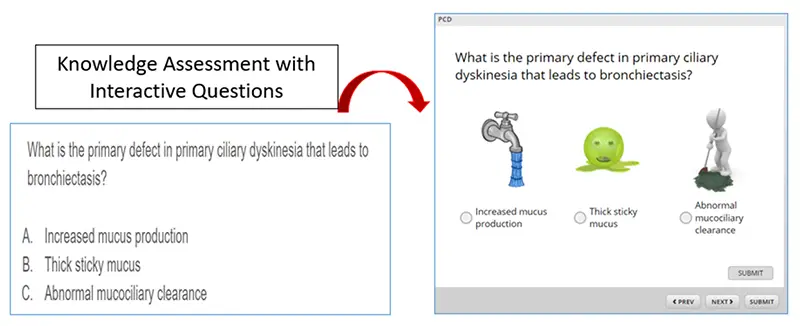Respiratory conditions are one of the most common reasons children are admitted to the hospital. Moreover, hospitalized pediatric patients are at high risk for developing respiratory complications that often progress to an end-stage disease. Despite the prevalence and seriousness of these illnesses in the pediatric population, the subspecialty of pediatric pulmonology is facing a physician shortage. According to Aliva De, MD, a pediatric pulmonologist at NewYork-Presbyterian and Columbia and president of the Pediatric Pulmonary Training Directors Association, many pediatric pulmonary programs are struggling with recruitment.
The most competitive subspecialities at NewYork-Presbyterian and Columbia will see upwards of 30 applicants per available position; by contrast some open pediatric pulmonology positions may not even get one applicant, Dr. De notes. To address this challenge, Dr. De and her colleagues sought to create an elective curriculum that would encourage medical students and pediatric residents to consider a career in pediatric pulmonology. Below, she describes their unique recruitment approach and NewYork-Presbyterian’s commitment to increasing the applicant pool for pediatric pulmonology fellowships and other subspecialties confronted with declining numbers.
How does developing an elective curriculum help with piquing trainees’ interest?
A study by one of my colleagues explored what factors might lead trainees to choose a subspecialty fellowship. A finding from that study showed that early introduction to the field was critical in enhancing their interest and helping tailor their future career goals. There appeared to be a lot of merit in that thinking. But there are currently no well-developed standardized courses for pediatric pulmonary electives published in the medical literature. Our goal was to develop a robust online asynchronous curriculum using digital multimedia resources that would close the current gap in content delivery to a wide spectrum of trainees.
How was the curriculum developed and what were the parameters of your related study?
The goal of our project was to standardize curricular content established in medical literature with enriched learning materials that incorporate multimedia technology and interactive tools to explain complex respiratory physiological and pathological concepts. Our program was launched shortly after the pandemic, which expanded the adoption of digital education and virtual learning, so we were able to leverage the digital tools that had become more readily available.
Our objectives were to test the effectiveness of this novel curriculum on learning outcomes, spur the trainees’ interests in pediatric pulmonology and evaluate their satisfaction with the program, and assess the popularity of the elective course.
Development of the revised course modules involved our current fellows and were guided by evidence-based adult learning principles that could help students and residents in structuring and monitoring their study progress. Specifically, the two- and four-week online programs included two components: interactive videos and case-based modules. The videos contain recorded audio and slides on various topics in pulmonary pathophysiology, diagnostic evaluation, respiratory failure and mechanical ventilation, interspersed with multiple-choice questions. The case-based modules incorporate self-paced multiple-choice questions and discussions centered around specific clinical scenarios, such as asthma, pneumonia, sleep apnea, and rare lung diseases.
We wanted the program to be engaging for the learners and to give them control over their learning. Posing questions to participants and allowing them to submit a response immediately followed by an educational component is a recognized way of enhancing adult learning. Testing knowledge first and then receiving instant feedback helps to improve retention. We also created a voluntary pre- and post-test of 20 questions to assess the effectiveness of the curriculum.

Example of an interactive case module
What was the criteria for participation in the curriculum study?
The pediatric pulmonary elective was open to third- and fourth-year medical students and and PGY 1, 2, and 3 pediatric residents rotating on our service between August 2020 and March 2023. We had 82 participants who completed the elective; 47 (57%) completed the pre- and post-tests.
How did you evaluate the success of the program?
The number of participants per year who selected the pulmonary elective was recorded as a measure of course popularity. Responses via an anonymous survey showed that 75 percent of participants agreed or strongly agreed that the online curriculum helped improve knowledge of common pediatric pulmonary disorders. Written feedback was also positive, with comments noting that both the case-based section and videos supplemented learning. We also saw an increase in the number of students and residents choosing our elective as word-of-mouth spread about the curriculum. In the three years before the new elective launched, we had an average of 8 rotators per year. In the three years after implementation, we saw an increase to an average of 29 rotators per year.
We felt the impact was greatest for the medical students, which was reflected in their higher pre- and post-test scores. We believe there was greater benefit for younger learners because the more advanced residents had competing responsibilities and demands on their time that made it challenging for them to benefit maximally from what we were offering. This reinforces the importance of exposure to subspecialty fields earlier, before trainees have finalized their career path.

Learners demonstrated improvement in their test scores after completing the curriculum, and gave positive feedback in their surveys
Going forward, are there plans to expand the curriculum beyond NewYork-Presbyterian and Columbia?
Increasing exposure to pediatric pulmonology as a potential career path early on is key. My involvement in the Pediatric Pulmonary Training Directors Association has enabled me to easily reach out to program directors across the country. Together, we have discussed the potential impact of our educational approach and how to expand and disseminate the curriculum beyond NewYork-Presbyterian and Columbia.
In addition, we have presented the elective curriculum project at national pediatric pulmonology meetings. I enlisted program directors and faculty nationally to peer review the curriculum. With their critical appraisal and feedback, we are now updating the content accordingly and once this is completed, we will make the curriculum more widely available.




